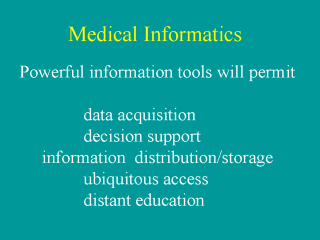 |
Fortunately,
medical informatics is beginning to mature. The central technologies will be data
acquisition, decision support, information distribution/storage, access and distant
education. Once biosignals or images are measured, the information systems will need to
acquire this information. This can be in a home personal computer, local home server, or
commercial secure website. This will be a personal data site, with all the appropriate
security and privacy integrated. Powerful decision support systems will analyze the
massive amounts of data, comparing it to the individualís legacy information to
determine any significant changes. Only those changes considered substantially outside of
norms for that individual will be used in an alert, first to the individual, and then to a
healthcare provider. The systems that analyze the information will likely be distributed
throughout the net, since it is unlikely all the decision support systems could or would
be contained on a single website. Secure distribution and storage of the medical data will
be an ongoing challenge, as will be determining access to the information. Not only will
the person or healthcare provider want access to individual information, but even more
important will be access to the appropriate medical educational and reference material.
Intelligent agents will be needed to sift through the petabytes of information to bring
only that information relative to the personís query. It will be essential to provide
trusted preventive medicine information through the Internet in a manner that is usable by
the individual patients, with a human user interface that stimulates and encourage
healthful behavior rather than confuses or frustrates those seeking advice. When
necessary, the Internet will be made available for tele-consultation, using systems that
are reminiscent of todayís primitive devices but which will greatly facilitate the
exchange of medical information and enhance the doctor-patient relationship. Current
advances using Internet 2 applications suggest that such relationships will be fully
interactive, 3-D immersive experiences which give the participants the sense of the
otherís presence Ė virtual reality over the Internet is referred to as tele-immersion.
|
